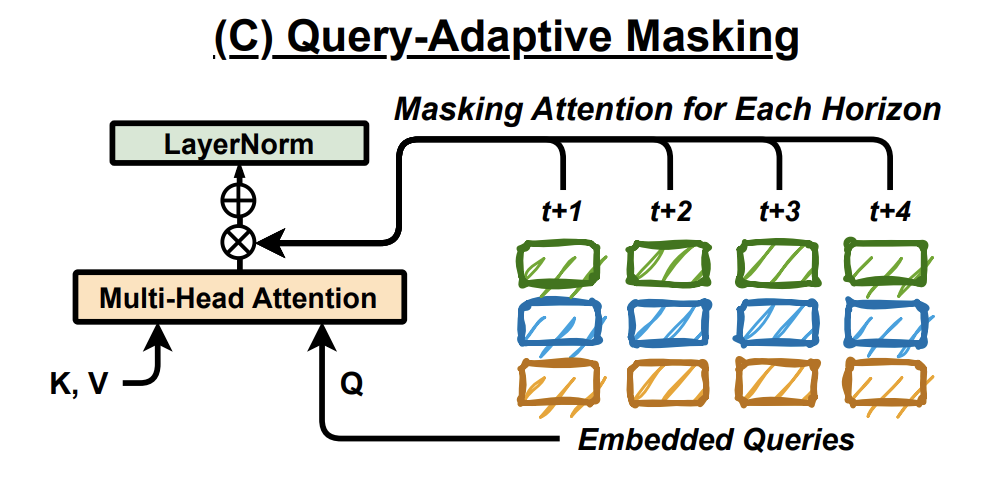Are Self-Attentions Effective for TS Forecasting?
Contents
- Abstract
- Introduction
- Temporal Information Encoding
- Proposed Methodology
- Experiments
0. Abstract
Transformer: effectiveness ??
This paper: Deals with Effectiveness of self-attentions for TS forecasting.
Cross-Attention-only TS Transformer (CATS)
- Self-attention (X) + Cross-attention (O)
- Establish future horizon dependent parameters as queries and enhanced parameter sharing,
1. Introduction
Are self-attentions effective for time series forecasting?
- (Previous works) [26]
- limited to substituting attention layers with linear layers
- Previous issues: because of …
- Self-attention (O)
- Transformer (X)
\(\rightarrow\) Aim to solve the issues of self-attention
& Propose a new forecasting architecture that achieves higher performance with a more efficient structure
Cross-Attention-only Time Series transformer (CATS)
-
Simplifies the original Transformer architecture
- self-attentions (X)
- cross-attentions (O)
-
Establishes future horizon-dependent parameters as queries
& Treats past TS data as key and value pairs
\(\rightarrow\) Enhance parameter sharing & improve long-term forecasting performance.
2. Temporal information encoding
Zeng et al. [26]
- Argued that self-attention is not suitable for TS
- Due to its permutation invariant and anti-order properties
- Self-attnetion
- Focus on building complex representations
- Inefficient in maintaining the original context of historical and future values.
- Proposed linear models without any embedding layer
Time-index models ( Woo et al. [22] )
-
Model the underlying dynamics with given time stamps
-
Imply that preserving the order of TS sequences plays a crucial role in TS forecasting
3. Proposed Methodology
(1) Problem Definition and Notations
MTS forecasting task
- Prediction: \(\tilde{\boldsymbol{X}}=\left\{\mathbf{x}_{L+1}, \ldots, \mathbf{x}_{L+T}\right\} \in\) \(\mathbb{R}^{M \times T}\)
- Target: \(\hat{\boldsymbol{X}}=\left\{\hat{\mathbf{x}}_{L+1}, \ldots, \hat{\mathbf{x}}_{L+T}\right\} \in \mathbb{R}^{M \times T}\)
- Input: \(\boldsymbol{X}=\) \(\left\{\mathbf{x}_1, \ldots, \mathbf{x}_L\right\} \in \mathbb{R}^{M \times L}\).

Traditional TS transformers
- Step 1) Embeddding \(\boldsymbol{X}\) to \(\boldsymbol{H}_L \in \mathbb{R}^{D \times L}\)
- (case1: CI) Considered to separate UTS \(\mathbf{x} \in \mathbb{R}^{1 \times L}\).
- (case2: Patching) Transforms into patches \(\mathbf{p}=\) \(\operatorname{Patch}(\mathbf{x}) \in \mathbb{R}^{P \times N_L}\)
- \(\boldsymbol{H}_L=\operatorname{Embedding}(\mathbf{p}) \in \mathbb{R}^{D \times N_L}\).
Notation
- Self-Attention (SA)
- Masked Self-Attention (MSA)
- Cross-Attention (CA)
- LayerNorm (LN)

For input tokens \(\boldsymbol{H}_T\) for cross-attention…,
- Positional embedding is often used
Output from the cross-attention, \(\boldsymbol{Z}_T^{(\mathrm{Dec})} \in \mathbb{R}^{D \times N_T}\), is subsequently used to produce the final prediction \(\hat{\boldsymbol{X}}\) through additional layers.
( If no decoder = Encoder-only models (Fig 2b) )
(2) Model Structure
Summary
-
Not only preserves the temporal information
-
But also utilizes the structural advantages of the Transformer
[Figure 2d]
- Cross-attention Transformer
- Maintain the periodic properties of TS
- ( not for self-attention, which has permutation-invariant and anti-order characteristics )
- Replacing with Linear layer??
- Potential of the transformer architecture itself (excluding self-attention) has been overlooked.
Introduce a novel approach!
\(\rightarrow\) Cross-attention without self-attention
Consists of three key components:
- (A) Cross-Attention with Future as Query
- (B) Parameter Sharing across Horizons
- (C) Query-Adaptive Masking

Details
-
Remove self-attention & Incorporate cross-attention
( + Utilize future data as the query )
-
Simplify the architecture by parameter sharing across forecasting horizons.
-
Enhance the performance through query-adaptive masking
a) Cross-Attention via Future as Query
Cross-attention mechanism:
- Query: From a different source than the key or value
\(\rightarrow\) Argue that each future horizon should be regarded as a question, i.e., an independent query.
Horizon-dependent parameters (as learnable queries)
Step 1) Create parameters ( = learnable queries \(\mathbf{q} \in \mathbb{R}^P\). )
- For the specified forecasting horizon
- ex) \(\mathbf{q}_i\) : Horizon-dependent query at \(L+i\).
Step 2) Utilize a cross-attention-only structure in the decoder
-
Resulting in an advantage in efficiency.
-
DECODER-only model

b) Parameter Sharing across Horizons
Strongest benefits of cross-attention via future horizon as a query \(\mathbf{q}\):
- CA is only calculated on the values from a single forecasting horizon and the input TS
Independent forecasting mechanism : Prediction \(\hat{\mathbf{x}}_{L+i}\) is …
-
Depenent on the past samples \(\boldsymbol{X}=\left[\mathbf{x}_1, \ldots, \mathbf{x}_L\right]\) and \(\mathbf{q}_i\)
& Independent of \(\mathbf{q}_j\) for all \(i \neq j\)
-
Notable advantage: a higher level of parameter sharing
Propose parameter sharing across all possible layers
- Embedding layer
- Multi-head attention
-
Projection layer
for every horizon-dependent query \(\mathbf{q}\)
In other words….
- All horizon queries \(\mathbf{q}_1, \ldots, \mathbf{q}_T\) (or \(\mathbf{q}_1, \ldots, \mathbf{q}_{N_T}\) )
- share the same embedding layer
- used for the input TS \(\mathbf{x}_1, \ldots, \mathbf{x}_L\) (or patches \(\mathbf{p}_1, \ldots, \mathbf{p}_{N_L}\) )
- before proceeding to the cross-attention layer
To maximize the parameter sharing,
also propose cross-dimension sharing
- use the same query parameters for all dimensions.
Projection (prediction) Layer:
-
Share the projection layer for each prediction.
- PatchTST: FC layer as the projection layer
- for the concatenated outputs \(\boldsymbol{Z}_T^{(\text {Dec) }}\).
- # of params: \(\left(D \times N_L\right) \times T\).
-
CATS: shares the same projection layer for each prediction.
-
# of params: \(D \times P\),
( not proportionally increasing to \(T\). )
-
- PatchTST: FC layer as the projection layer

c) Query-Adaptive Masking
[Limitation]
High degree of parameter sharing: could lead to…
- overfitting to the keys and values (i.e., past time series data),
- rather than the queries (i.e., forecasting horizon).
[Solution]
To ensure the model focuses on each horizon-dependent query \(\mathbf{q}\)
\(\rightarrow\) Introduce a new technique that masks the attention outputs

-
For each horizon, we apply a mask to the direct connection from Multi-Head Attention to LayerNorm with a probability \(p\).
-
Result: Prevents access to the input TS
\(\rightarrow\) Resulting in only the query to influence prediction
-
Helps the layers to concentrate more effectively on the forecasting queries.
4. Experiments
(1) LTSF

(2) Efficiency & Robust Forecasting for Long Input Sequences


